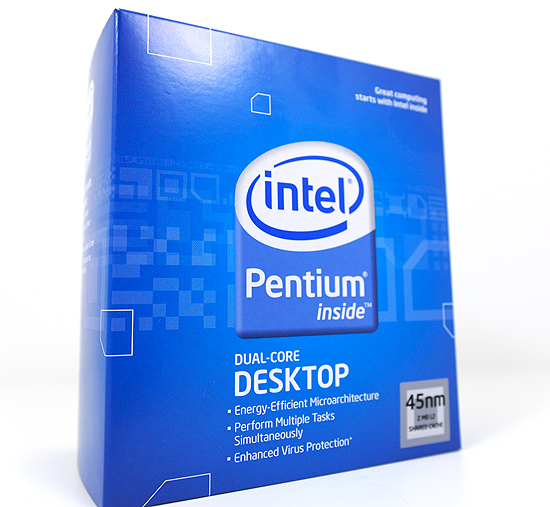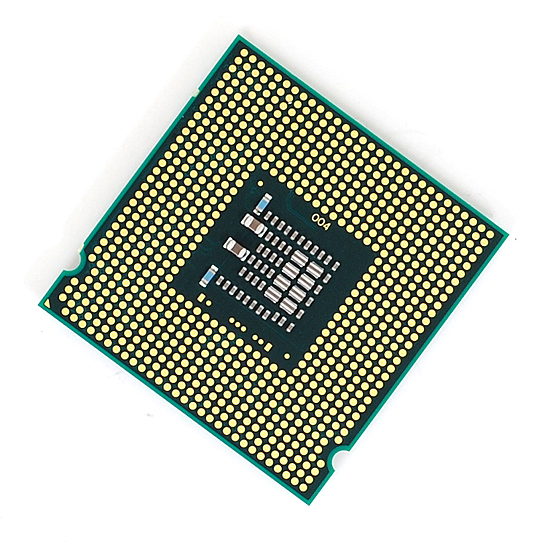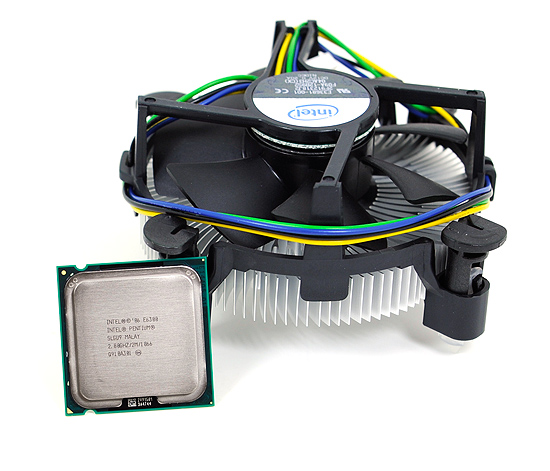The Athlon II X2 & Phenom II X2: 45nm Dual-Core from AMD
by Anand Lal Shimpi on June 2, 2009 12:00 AM EST- Posted in
- CPUs
Intel’s Response: The Pentium E6300
AMD has two new dual-core chips priced at $87 and $102, both run at or around 3.0GHz and have a fair amount of cache. The Athlon II X2 250 has a 1MB L2 per core (2MB total) while the Phenom II X2 550 BE has a large 6MB L3 to share between its two cores. These are both very healthy sounding processors, borderline scary if you’re Intel.

The Pentium E6300
In the blue corner we have the new Pentium E6300. It’s a 45nm monolithic dual-core part, just like the Athlon II X2. It has a 2MB L2 cache also like the Athlon II X2, albeit shared between the two cores which is potentially an upside. Unlike previous Pentium for Desktop (that’s the official name) processors, the E6300 uses a 1066MHz FSB and it supports Intel’s VT. The problem? The E6300 only runs at 2.80GHz; AMD has a clock speed advantage.


In our first Phenom II review I talked about how AMD needs a clock speed advantage to compete. Compared to a large-cache Core 2, that’s very true, but the E6300 doesn’t have a healthy 6MB L2 for two cores. It’s only got 2MB. All of the sudden things aren’t looking so rosy for Intel.

An inherent advantage of Intel’s Core architecture is its 4-issue front end (which in some cases can behave like a 5-issue front end). The problem is feeding such a beast requires very fast memory access. The Pentium E6300 is still based on the same architecture as the Core 2 Duo, meaning it has no on-die memory controller. Rob it of a decent sized cache and its performance suffers. A quick look at Bench shows us that even an extra megabyte of cache helps tremendously:
| Processor | SYSMark 2007 Overall |
| Intel Core 2 Duo E7500 (2.93GHz/3MB L2) | 173 |
| Intel Pentium E6300 (2.80GHz/2MB L2) | 158 |
Note that when Conroe first launched some parts (the Core 2 Duo E6300 funny enough) only had a 2MB L2. The problem is that was nearly three years ago; applications have grown in size and so have their demands from processors. What was acceptable back then is now not. I’d like to see Intel move its 3MB L2 caches down to these sub-$100 price points. But I’ll let the benchmarks decide whether or not it’s necessary.
| Processor | Clock Speed | L2 Cache | TDP | Price |
| Intel Core 2 Quad Q9650 | 3.00GHz | 12MB | 95W | $316 |
| Intel Core 2 Quad Q9550 | 2.83GHz | 12MB | 95W | $266 |
| Intel Core 2 Quad Q9400 | 2.66GHz | 6MB | 95W | $213 |
| Intel Core 2 Quad Q9300 | 2.50GHz | 6MB | 95W | $213 |
| Intel Core 2 Quad Q8400 | 2.66GHz | 4MB | 95W | $183 |
| Intel Core 2 Quad Q8300 | 2.50GHz | 4MB | 95W | $183 |
| Intel Core 2 Quad Q8200 | 2.33GHz | 4MB | 95W | $163 |
| Intel Core 2 Duo E8600 | 3.33GHz | 6MB | 65W | $266 |
| Intel Core 2 Duo E8500 | 3.16GHz | 6MB | 65W | $183 |
| Intel Core 2 Duo E8400 | 3.00GHz | 6MB | 65W | $163 |
| Intel Core 2 Duo E7500 | 2.93GHz | 3MB | 65W | $133 |
| Intel Core 2 Duo E7400 | 2.80GHz | 3MB | 65W | $113 |
| Intel Core 2 Duo E7300 | 2.66GHz | 3MB | 65W | $113 |
| Intel Pentium E6300 | 2.80GHz | 2MB | 65W | $84 |
| Intel Pentium E5400 | 2.70GHz | 2MB | 65W | $84 |
| Intel Pentium E5300 | 2.60GHz | 2MB | 65W | $74 |
| Intel Pentium E5200 | 2.50GHz | 2MB | 65W | $64 |
| Intel Pentium E2220 | 2.40GHz | 1MB | 65W | $64 |
| Intel Pentium E2200 | 2.20GHz | 1MB | 65W | $64 |
| Intel Celeron E1500 | 2.20GHz | 512KB | 65W | $53 |
| Intel Celeron E1400 | 2.00GHz | 512KB | 65W | $43 |
| Intel Celeron 450 | 2.20GHz | 512KB | 35W | $53 |
| Intel Celeron 440 | 2.00GHz | 512KB | 35W | $44 |
| Intel Celeron 430 | 1.80GHz | 512KB | 35W | $34 |










55 Comments
View All Comments
Gary Key - Tuesday, June 2, 2009 - link
The X2 6400+ is in the charts now and you can always use our Bench tool to compare a whole litany of processors against each other. AMD is currently phasing out of 90nm production and even several 65nm products will be phased out this year as they ramp the 45nm production.Spoelie - Thursday, June 4, 2009 - link
WOW, it really amazes me how little performance has improved. Athlon II X2 750 (3ghz) is barely faster in most benchmarks than a Athlon X2 6400+ (3,2ghz), and loses in 1 or 2.So the phenom core redesign buys around 300mhz around 3ghz, or only 10%. Everything else that improved in phenom is uncore.
And this while the original is at 90nm and the new one is 45nm, what a waste of potential. It seems to me AMD could've tried a little harder with the Athlon II.
Spoelie - Tuesday, June 2, 2009 - link
There's a small util/service out there that brings phenom II cnq behaviour from vista over to windows xp (phenom II's cnq behaves like phenom I's cnq under windows xp). It does this by disabling standard cnq (set power management not on "minimal") and implementing pstate changing itselfhttp://home.comcast.net/~pmc650/site/?/page/CNQ_Ph...">http://home.comcast.net/~pmc650/site/?/page/CNQ_Ph...
Maybe it can do the same for the Athlon II X2 on vista...
mohindar - Tuesday, June 2, 2009 - link
Hello Anand,It will be very nice to provide some benches regarding desktop virtualization, like how windows-xp usage on this chip and so on...
plonk420 - Tuesday, June 2, 2009 - link
i'm curious to see this on the bench!mapesdhs - Tuesday, June 2, 2009 - link
I'm beginning to wonder whether AMD/Intel are making the same mistake
we saw last year with gfx cards, ie. too many different options. What
is the target market for the new AMD CPUs? Many retailers seem to
offer just a small selection.
Any chance you could add an i7 920 and a 6000+ to the tables please?
The former for completeness, the latter to show how the newer AMD
parts stack up against a typical older product. I'd been hoping for
a suitable replacement for the 6000+ in my ASUS board, but still nothing (no BIOS support).
Atm it looks like my next system will be an i7 920 setup (core task
is video encoding). In the past there's been lots of talk about the
higher cost of an i7 system, but looking around yesterday, I was
surprised at how small the difference has now become. The i7 920 is
only 18% more than the Ph2 955 BE. Expecting a larger difference for
the mbd cost, I found an X58 board from Gigabyte (the GA-EX58-UD3R,
135 UKP from LambdaTek) right in the middle of the price range of
typical AM3 boards. They both use DDR3, so that isn't a factor. I
was going to build a Ph2 955 BE system for my brother as his next
gaming rig, but with such small price differences now in play, the
i7 looks more sensible.
Oh, a typo on the first page perhaps? Surely it should be 2 cores for
the Athlon64 X2?
Ian.
smilingcrow - Tuesday, June 2, 2009 - link
Judging by other reviews your choice of using the x264 HD Bench Pass 1 for the Power Consumption comparison doesn’t give a true representation of the situation.As expected other reviews shows the Athlon II X2 having a noticeably lower power consumption under typical loads.
The Phenom II X2 has too much extra circuitry to have lower power consumption and I’m surprised that you didn’t deduce that something was amiss.
Anand Lal Shimpi - Tuesday, June 2, 2009 - link
As I mentioned on the power consumption page, I'm guessing it has more to do with the current level of BIOS support for the Athlon II's power management. AMD is expecting a much better situation in the coming weeks.Take care,
Anand
Eeqmcsq - Tuesday, June 2, 2009 - link
The one comparing various Athlon X2 specs. The table says the Athlon 64 X2 has 4 cores.Anand Lal Shimpi - Tuesday, June 2, 2009 - link
Woops, thank you :)-A